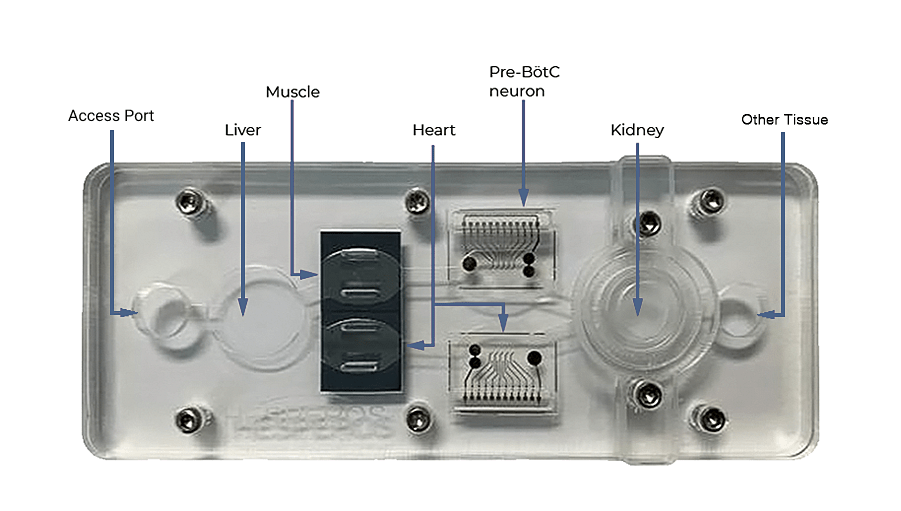What is a Human-on-a-Chip®?
Interconnected, reconfigurable, multi-organ in vitro platform reproducing the functional aspects of human physiology providing unprecedented visibility into how the human body will respond to chemicals & novel therapeutics.

Access port enables drug delivery, and daily medium exchanges to mimic excretion and replenish nutrients.
- 1 of 7
 Liver
Liver
Competent patient derived liver metabolizes compounds accurately translating to in vivo results.
- 2 of 7
Monitor changes in muscle contraction and force in response to treatment.
- 3 of 7
 Heart
Heart
Monitoring of beat frequency, force, and conduction velocity enables real-time, functional changes tracking toxicity levels as drugs enter and clear the system
- 4 of 7
 Brain
Brain
Tack the effect on neurons. In this case, pre-BotC which are interneurons located in the brain stem and responsible for respiration. The primary neurons effected in during an overdose.
- 5 of 7
 Kidney
Kidney
Monitor acute kidney damage from drug dosing as well as function recovery as it clears the system.
- 6 of 7
Choose from an ever-growing list of available tissues in your custom model:
- Heart
- Liver
- Neurons
- Skeletal Muscle
- Kidney Renal Proximal Tubule (RPT)
- Blood-Brain Barrier (CNS)
- GI Tract
- Immune System
- 7 of 7
Example 5-organ system configured to study the effects of an opiod overdose
Read more about this project funded by NIH's HEAL initiative here.
What's in each System?
Explore the various aspects that make up the worlds' most advanced human-based, multi-organ system
Available Organ & Barrier Tissues
Select from the following available modules depending based on your applications.
| Organs | Barrier Tissues |
|---|---|
| Heart | Blood-Brain Barrier (CNS) |
| Liver | Skin |
| Neuron | GI Tract |
| Skeletal Muscle | Kidney RPT |
*The addition of an Immune System is also available along with Fat or Bone Marrow
What cells are used?
Each organ chip is made up of either primary (patient donated cells) or stem cell derived (iPSC).
Microelectromechanical chips are used to monitor changes in function for specific organ modules. By tracking, for example, changes in cardiac beat frequency and force, we are able to see the real time impact on organs as a compound enters the system and then recovers as it clears.
This is a more precise and useful toxicity metric than standard biomarkers which rely on cell viability alone.
Unlike other tests that extrapolate organ function based on biomarker activity and protein analysis, our models are working systems that recreate muscle and tissue function as well as neural and organ-organ communication.
A custom, non-animal formula of growth factors is used to maintain health of the system without influencing the impact.
Mimicking blood flow, the serum free media delivers oxygen and nutrients to organ tissues. This allows a clear understanding of exactly how your compound will impact the human body, both acutely and over time.
Key Advantages
Explore the various aspects that make up the worlds' most advanced human-based, multi-organ system
Flexibility
Easily interchange which organ modules to best fit your application.
This includes flexibility on how to dose your compound - whether intravenously (IV), ingested orally (Gut), or absorbed through the skin.
Functional Readouts
Non-invasively track the changes in function over time. This information then informs PK/PD models. Patented microelectromechanical devices enable non-invasive, real-time monitoring of organs.
Scalability
The low-volume system requires only milligram compounds of a candidate compound. Thanks to the A carefully designed gravity flow system eliminates the need for pumps to better represent human (in vivo) conditions.
Testimony by Francis Collins to Senate Labor, Health & Human Services Subcommittee, April 7, 2016

I predict that, ten years from now, safety testing for newly developed drugs as well as assessment of the potential toxicity of numerous environmental exposures, will be largely carried out using human biochips … [and] will mostly replace animal testing for drug toxicity and environmental sensing giving results that are more accurate, at lower cost, and with higher throughput.
NIH Director, Francis Collins, MD, PHD
Other Capabilities
Pharmacokinetic/Pharmacodynamic (PK/PD) Modeling
Data from functional readouts are fed into PK/PD models to better predict clinical outcomes.
High Performance Liquid Chromatography (HPLC)
Using our Agilent Technologies HPLC-MS, we can quantify the concentration of drug in systems at any point during an experiment.
Explore
Get in Touch
Hesperos, Inc.
12501 Research Parway, Suite 100
Orlando, Florida 32826
(407) 900-5915
info@hesperosinc.com
